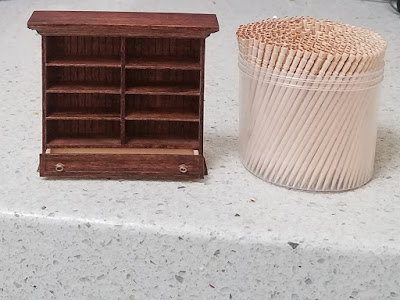Back
to furniture making! I decided to start with
something simple and selected the smaller bookcase that goes along the
left-hand wall. When enlarging and
lightening one of the pictures of the bookcase, I realized that it has a drawer
along the bottom. (Maybe two; it’s hard
to tell because the chair is in the way.
Because our home has a lovely built-in with a long drawer along the
bottom, I decided to make one long drawer on the bookcase.)
I
started with my drawing in Word. Planning
in this way really helps me play with proportions and gives me something to cut
out and place in the space, so that I can see how it’s going to work. I also adjust my plans to fit standard strip
wood dimensions. There’s only so much
wood cutting I can do. 😊 For this bookshelf, I used mostly 1/16” thick
bass strip wood, with the exception of the shelves and the drawer front; they
are all 1/32” thick. The shelves are 1/2”
deep. The drawer front is cut from 3/8”
wide strip wood.
Once
my pieces were cut and stained, I put together the inside of the drawer first. I like to use a face plate on my drawers, as I
think it gives them a cleaner look, but I needed the inside put together to
make sure I accommodated it when gluing together the bookcase. I don’t bother staining the wood on the
inside of the drawer; I just glue it together in my little gluing jig. Here are some pictures of the finished
drawer, so that you can see what I’m talking about.
Once
I had the inside of the drawer glued together, I could start gluing my main
shelves and shelf-divider. Because I had
that drawer at the bottom, I couldn’t use my trick of extending the vertical line
on my pattern and laying the back of the bookcase on top, to ensure proper
placement of the divider. Fortunately,
the bookcase takes beadboard at the back, so I could just line my divider up
along one of the “boards.” You can see I
used my Lego blocks to make sure that the pieces were glued in at right angles.
Once
the sides were glued on, I glued the face plate onto my drawer, and trimmed it
out with HO scale lumber. I trimmed the
bottom of the bookcase with quarter round.
Then I used the spacers from the first bookcase I built to glue in my
shelves.
If any of you have followed the thread on Greenleaf forums about half-scale hardware, you’ll know that it’s extremely difficult to find. I make my own “Chippendale” drawer pulls. I start with a piece of cardboard and lay out repositionable (not permanent!) double-stick tape. I cut small diamonds from heavy card stock. The color doesn’t matter, since I paint them. It just happens that the heaviest card stock I have is colored gold. I tried to find a nice shape I could make with a punch, but nothing quite worked for me. If you have a punch that you like, you could use that, too. You could also cut ovals, or, if you are going for more of a craftsman look, rectangles. I place my diamonds on the tape, and lay another strip of cardstock just below them, to give the bottom of the pulls something to rest on while I’m gluing, so that they’ll hang straight.
Then
I remove links from a fine chain and use super glue to glue them to my
cardstock diamonds.
Once
the glue is dry, I remove the extra strip of cardstock. Finally, I paint the whole thing (chain link
and diamond) with Testor’s enamel paint.
Sometimes I use gold. This time,
I mixed a little flat black in with the gold to give it a more antique
look. When the paint is dry and I’ve
finished varnishing my drawer, I can simply lift the drawer pull assembly off
the removable tape and glue it to my drawer front with a little tacky glue.
While
waiting for my paint to dry, I added the cornice and a final piece of strip
wood to the top of my bookcase. I gave the
whole thing three coats of satin varnish, using 0000 steel wool to smooth it in
between coats and after the final coat.
And
here it is in place. I may reframe that
painting. The frame I made isn’t really
heavy enough.
The
figurine (which in the original is the Japanese god of benevolence and hunting)
is one of a group of tiny bonsai mudmen I scored off eBay a while ago. The buffalo is a little large, but that’s all
I’ve been able to find so far, and the small Asian blue-and-white vase, is, of
course, a bead from Michael’s.
































